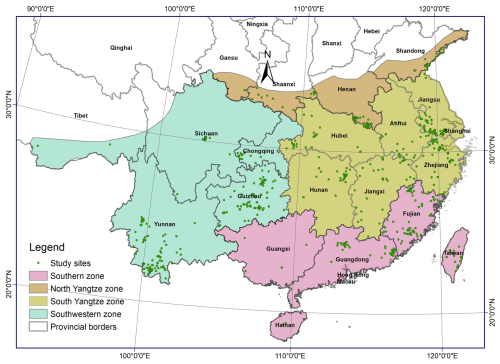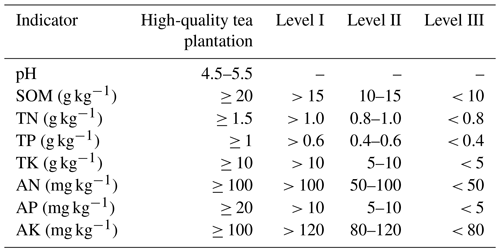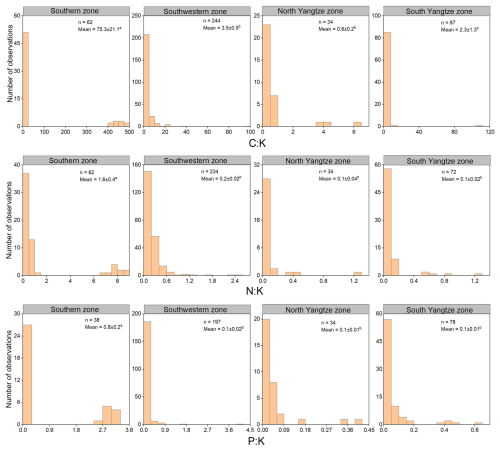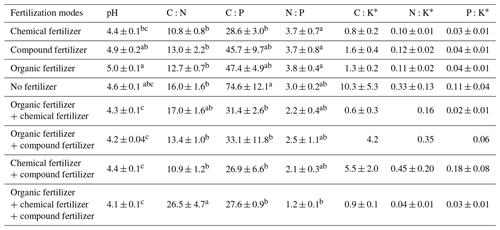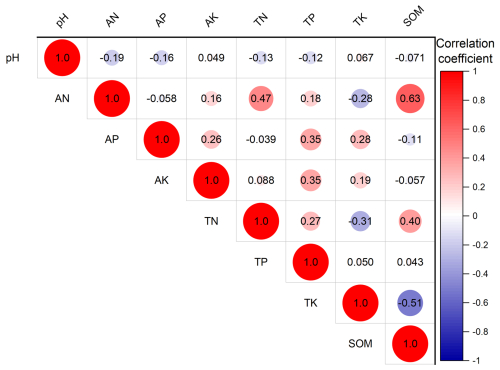the Creative Commons Attribution 4.0 License.
the Creative Commons Attribution 4.0 License.
Status and influential factors of soil nutrients and acidification in Chinese tea plantations: a meta-analysis
Dan Wang
Benjuan Liu
Fei Li
Zhihui Wang
Jianfeng Hou
Rui Cao
Yuqian Zheng
Wanqin Yang
Knowledge of the status and influential factors of soil nutrients including soil organic matter (SOM), nitrogen (N), potassium (K), phosphorus (P), and acidification is the basis for sustainable management of tea plantations and thus the sustainability of the tea industry. However, a national-level study addressing this topic is lacking. Thereby, we assessed the status, spatial variations, and influential factors of soil nutrients and acidification in China's tea plantations based on 1843 datasets collected from 379 published articles. The results showed that only 40.9 % of the observed tea plantations meet the standards of high-quality tea plantations. Most tea plantations were facing soil acidification, nutrient deficiencies, and imbalance. Furthermore, the status of soil nutrients and pH varied among cultivation zones due to the impacts of location, climate, and soil type. Specifically, tea plantations in the southern zone showed the lowest concentrations of available N, available K, and total K but the highest stoichiometric ratios of soil nutrients (P < 0.05). Management practices (e.g., rotational cycle and fertilization strategies) also significantly shaped the status of soil nutrients and pH. Therefore, applying organic fertilizer, extending the duration of the cultivation cycle, and planting shading trees were recommended to improve soil nutrient availability and balance, as well as to mitigate soil acidification. Specifically, it is recommended to apply K fertilizer to tea plantations in the southern zone and/or at high altitudes.
- Article
(4982 KB) - Full-text XML
-
Supplement
(306 KB) - BibTeX
- EndNote
Tea plants (Camellia sinensis (L.) O. Kuntze) are widely cultivated as an important economic crop in many countries such as China, Kenya, India, Sri Lanka, etc. (FAO and CAAS, 2021). Globally, the cultivation area and yield of tea have increased annually to meet the growing demand (FAO, 2024). China is the largest tea grower, producer, and consumer around the globe (FAO and CAAS, 2021), and its cultivation area, including Taiwan (CAEY, 2023), grows fast, expanding from 1.1×106 ha in 2000 to 3.4×106 ha in 2022 (NBS, 2024). The expanding tea cultivation area occupies other land uses (Li et al., 2011; Zhu et al., 2017; Wu et al., 2020). Together with monoculture and the intensive and/or improper use of chemical fertilizer (Yan et al., 2018), soils in Chinese tea plantations are degrading, such as soil acidification and nutrient imbalance (Yang et al., 2023), which may influence the productivity and quality of tea and cause ecological and environmental problems. Therefore, assessing the status of soil nutrients and acidification and identifying the key influential factors are crucial for soil management in tea plantations and vital to tea production and environmental protection.
The concentrations and availability of soil organic matter (SOM), nitrogen (N), potassium (K), and phosphorus (P), as well as pH, are important indicators of the health and fertility level of the soil to support plant growth (Zhu et al., 2021). The stoichiometric ratios of carbon (C), N, P, and K reflect the restrictions, overloads, and imbalances in soil nutrients (Su et al., 2019), determining nutrient availability for plants and soil microorganisms and further affecting ecosystem functions (Zheng et al., 2021). Although local and regional statuses of soil nutrients have been widely investigated (Hua and Li, 2018; Yan et al., 2018; Zhang and Shu, 2021), knowledge concerning the status and spatial variation of soil nutrients and the influential factors in tea plantations at the national level is lacking. Soil pH affects many physical, chemical, and biological soil properties and processes, influencing plant growth and biomass yield (Neina, 2019). As an important aspect of soil degradation, soil acidification has been widely reported across various ecosystems and regions, such as cropping systems (Zhu et al., 2018) and tobacco plantations in China (Zhang et al., 2016), 21 land use types in Britain (Malik et al., 2018), and global terrestrial ecosystems (Chen et al., 2023). Soil acidification increases the leaching loss of cationic nutrients and exacerbates the imbalance of soil nutrients (Zhang et al., 2016); it also causes losses of soil inorganic carbon (Raza et al., 2021). Soil acidification in tea plantations gains specific attention because of the special property of the tea plant which prefers acidic soil for growth and in turn acidifies soil (Yan et al., 2018). Yan et al. (2020) have reported the status and variation of soil acidification in China's tea plantations based on 2058 datasets collected from the literature, covering 225 tea-planting counties in 19 provinces in mainland China, and have analyzed its historical change trend (between the 1980s and 2000s). Zhang et al. (2022) have reported on the soil pH in China's tea-planting provinces and on the variations in altitudes and tea varieties based on data collected from 122 articles. However, little information about what and how influential factors affect soil pH in tea plantations at a national level is available.
The status of soil nutrients (Zheng et al., 2012) and pH (Yan et al., 2020) varies spatially and is strongly influenced by environmental factors, such as location (e.g., longitude and latitude), topography (e.g., elevation), soil conditions (e.g., soil type), and climate (e.g., temperature and precipitation) (Chen et al., 2022). To begin with, location and topography determine the spatial distribution of hydrological, climatic, and pedological properties and are thus likely to alter the concentrations and distributions of soil nutrients (Shao et al., 2022). For instance, Wang et al. (2018) have demonstrated that soil total nitrogen (TN) and soil organic carbon (SOC) are positively correlated with elevation in non-karst soils. Meanwhile, the physicochemical conditions of soil, such as texture, bulk density, pH, and nutrient concentrations, vary markedly with soil types and determine the status of soil nutrients (Di et al., 2020). Ge et al. (2019) have reported that the concentrations and ratios of soil C, N, and P were significantly affected by clay content of soil (Baker et al., 1998). Besides, climatic factors not only affect the growth and distribution of vegetation (Shao et al., 2022) but also affect the mineralization and immobilization of organic materials (Xin et al., 2016), suggesting that climate factors are key drivers of the concentrations and stoichiometric ratios of soil nutrients. Together, the status of soil nutrients and pH may depend on environmental conditions. However, the status of soil nutrients and pH in tea plantations at a national scale as well as the key drivers remains unknown.
Agronomic management practices can alter the status of soil nutrients and pH in artificial ecosystems (Ronnenberg and Wesche, 2011). On the one hand, extensive disturbance of surface soil and biomass harvesting in agroecosystems accelerate the decomposition of SOC and soil degradation; therefore, agroecosystems are generally considered to have lower SOC (Rodríguez Martín et al., 2016), N, and P storage than natural ecosystems (Zhu et al., 2021). However, Fan and Han (2020) have reported that tea plantations have higher soil TN than forests and that a 100-year-old tea plantation holds higher SOC than a forest. On the other hand, fertilizer application can replenish soil nutrients but may also cause imbalances in soil nutrients and soil acidification, as well as other environmental problems depending on fertilization strategies (Vitousek et al., 2009). Generally, organic fertilizer can improve crop productivity, as well as increasing concentrations of soil nutrients, resisting soil acidification (Shi et al., 2019) and reducing nutrient runoff losses (Yan et al., 2023). Inorganic fertilizers can efficiently improve the concentrations of available macronutrients, but they may also cause soil acidification and imbalance of soil nutrients (Jin et al., 2023). Excessive N fertilization is particularly recognized as a major cause of serious soil acidification in China's tea plantations (Yan et al., 2020). Consequently, the combined application of organic and inorganic fertilizers is considered the best way to balance soil nutrients (Quan et al., 2020), and knowledge regarding the effects of management practices on the status of soil nutrients in tea plantations is the basis for sustainably managing tea plantations.
Therefore, to obtain knowledge regarding the effects of environmental factors and management practices on the status of soil nutrients and pH, this study assessed the status of soil nutrients and pH in China's tea plantations. We aimed to answer the following three questions. (1) What is the status of soil nutrients and pH in China's tea plantations? (2) How do geological and climatic factors, as well as management practices, influence the concentrations and stoichiometric ratios of soil nutrients and pH? (3) What measures can be taken to address the possible soil problems? Our findings could provide valuable references for the sustainable management of tea plantations.
2.1 Study area
The study area encompasses all 20 tea-planting provinces in China (Fig. 1). These provinces were divided into four cultivation zones: southwestern zone, southern zone, south Yangtze zone, and north Yangtze zone (Zhang et al., 2017), based on tea types, soil types, and climate (FAO and CAAS, 2021; Wang et al., 2023).
2.2 Data collection and compilation, as well as assumptions
Articles published from January 2000 to May 2023 were searched and collected using keywords “stoichiometry”, “soil fertility”, “soil nutrient”, or “soil organic matter” plus “tea plantation” or “tea garden” through China National Knowledge and Web of Science. Collected articles were filtered based on the following criteria: (1) experiments were conducted in the field, and (2) the soil depth was indicated as thicker than 10 cm in the literature. After filtering, 379 published articles met the criteria and were selected for data collection. In total, 1843 datasets were collected and compiled into the database. The database included the concentrations and stoichiometric ratios of soil nutrients: TN; total phosphorus (TP); total potassium (TK); available nitrogen (AN); available phosphorus (AP); available potassium (AK); pH; SOC; SOM; and the ratios of C:N, C:P, N:P, C:K, N:K, and P:K. Other information regarding soil classification, sampling depth, age of tea plantation, cultivation zone, longitude, latitude, elevation, mean annual precipitation (MAP), mean annual temperature (MAT), and fertilization strategy was also collected and recorded in the database. Soil classifications referred to the “Classification and Codes for Chinese Soil” (GB/T 17296-2009) to ensure consistency and comparability with the literature as most studies where we collected data from used the Chinese soil classification system. Translating soil types between different soil classification systems may cause uncertainty due to differences in scientific basis, classification principles, and hierarchy, etc. (Table S1 in the Supplement). The characteristics of representative soil classifications in tea cultivation zones are illustrated in Table 1. The central longitude and latitude of the administrative district of the study area were adopted if the exact locations of the sampling sites were not reported. Then, all units were unified to ensure consistency among studies.
Table 1Main characteristics of representative soil classifications in tea cultivation areas. The table was adapted from Zhu et al. (2019).
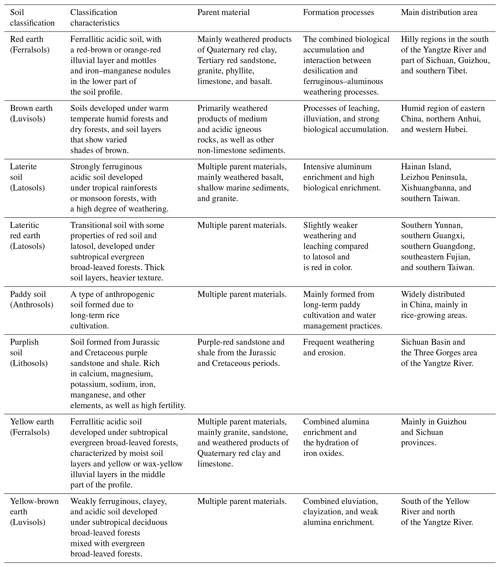
In this study, a soil depth of 0–30 cm was used to explore and compare the concentrations and stoichiometric ratios of soil nutrients; however, the sampling depths varied among the published articles. Under this circumstance, certain assumptions and data processing methods were applied to standardize the soil depths. In some articles, soil depths were 0–30 cm or thicker, but they were divided into several layers; for example, sampled soils were divided into layers of 0–10, 10–20, and 20–30 or 0–20 and 20–40 cm. In these cases, the average values of all soil layers were considered equivalent to those in the 0–30 cm soil layer. In other articles, the soil depths for sampling were less than 0–30 cm, e.g., 0–20 cm. In these cases, the stoichiometry of soil nutrients in the 0–20 cm soil layer was assumed to be the same as that in the 0–30 cm soil layer.
2.3 Data processing and analysis
Calculations were conducted for articles that reported only partial information about soil nutrients. Conversion between SOM and SOC was performed using a constant of 1.724 to divide SOM or multiply SOC (Fang et al., 2012). The stoichiometric ratios of soil nutrients were expressed in mass ratios of SOC, TN, TP, and TK. Mass ratios are commonly used in the literature where we collected data from and other meta-analyses of soil nutrients (Shi et al., 2016). For studies that only reported the concentrations of soil nutrients or calculated stoichiometric ratios based on molar data, the ratios of C:N, C:P, N:P, C:K, N:K, and P:K were calculated and adjusted by multiplying the molar masses of the elements before analysis to ensure consistency and comparability among studies.
Statistical analyses were conducted using SPSS software ver. 23 (SPSS Inc., Chicago, IL, United States of America). One-way ANOVA was performed to assess differences in the stoichiometry of soil nutrients and pH among tea cultivation zones, fertilizer strategies, and soil classifications. Subsequently, post hoc multiple comparisons between two groups were conducted using the Tukey HSD (honestly significant difference) method. Correlations between the stoichiometry of soil nutrients and pH, geological and climatic factors, and age of tea plantations were analyzed to explore the factors influencing soil nutrient status and acidification. The correlations between soil nutrients and pH were analyzed and visualized using OriginPro 2024 software (OriginLab Corporation, Northampton, MA, United States of America). The effect strengths of longitude, latitude, elevation, MAT, MAP, and age of tea plantations on soil nutrients and pH were compared using the standardized β coefficients from regression analyses. Additionally, multi-way ANOVA was performed to compare the effects of fertilizer strategies and soil classifications. The significance of all statistical tests was set to the 0.05 level.
2.4 Classification of tea plantations
Tea plantations were classified into four levels based on the concentrations of soil nutrients (Table 2), in accordance with the “Chinese Standards of Environmental Requirement for Growing Area of Tea” (NY/T 853-2004) and the soil nutrition diagnostic indicators of high-quality tea plantations (Zhang and Shu, 2021).
3.1 Status and variations of soil nutrients and pH
At the national level, the average concentrations of all soil nutrients, except for TP, were higher than the standards for soil nutrients in high-quality tea plantations (Tables 2–3). However, the concentrations of soil nutrients, especially for available nutrients (AN, AP, and AK), varied greatly among tea plantations. The status of soil nutrients in 40.9 % of the observed tea plantations met the standards for high-quality tea plantations, but more than 20 % of tea plantations were classified as level III tea plantations due to deficiencies in soil nutrients and unsuitable soil pH. Importantly, 46.5 % and 32.0 % of observed tea plantations showed deficiencies in soil AK and TP, respectively, and the pH of 52.9 % of the soil samples fell outside the optimal soil pH for tea growth (4.5–5.5). Notably, the stoichiometric ratios of soil nutrients in China's tea plantations varied widely, especially for the ratios of C:N, C:P, and C:K (Table 3 and Figs. 5–6), indicating that some of China's tea plantations were facing a serious imbalance of soil nutrients. We also observed that the concentrations of available N, P, and K in some tea plantations were very high (Fig. 3).
Table 3Concentrations and stoichiometric ratios of soil nutrients in Chinese tea plantations.
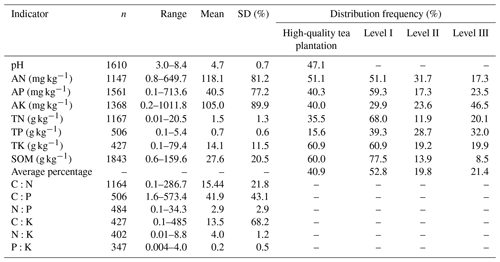
n is the number of observations. SD: standard deviation.
Spatially, the ecological stoichiometry of soil nutrients and pH varied markedly among cultivation zones (Figs. 2–6). Specifically, tea plantations in the southwestern zone had the highest concentrations of soil AN and SOM, while tea plantations in the southern zone showed the lowest concentrations of soil AN, AK, and TK (P < 0.05). The soil pH of tea plantations in the north Yangtze zone was significantly higher than in other zones (P < 0.05) (Fig. 2). In terms of the percentage of high-quality tea plantations, the south Yangtze zone showed the highest percentage (50.1 %), while the southern zone had the lowest percentage (28.1 %) due to low concentrations of AN, AK, and TK and an extremely low concentration of TP (Figs. 3–4). Less than half of tea plantations in the southwestern (47.9 %) and north Yangtze (45.6 %) zones met the standards for high-quality tea plantations. Stoichiometric ratios, except for C:N and C:P, of soil nutrients in the southern zone were significantly higher than those in other cultivation zones. Furthermore, concentrations of SOM, TP, TK, AN, and AK, as well as ratios of C:N, C:P, N:P, and P:K, varied widely among tea plantations in the southwestern zone, while concentrations of soil AN, AP, AK, TN, and TK varied widely among tea plantations in the south Yangtze zones; concentrations of SOM and AP, as well as ratios of N:P, C:K, N:K, and P:K, varied markedly among tea plantations in southern zones.
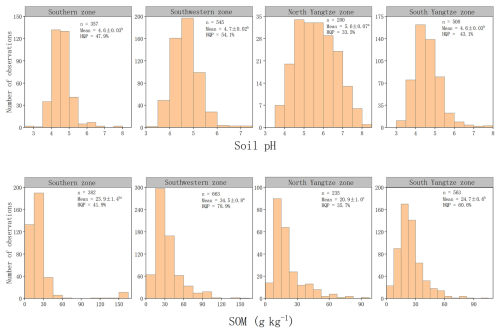
Figure 2Frequency distribution of soil pH and SOM in tea plantations in each cultivation zone. n is the number of observations; HQP represents the percentage of high-quality tea plantations; letters on values indicate significant differences among cultivation zones at the 0.05 level.
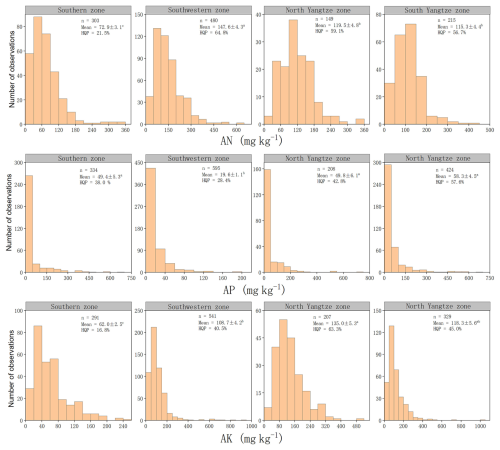
Figure 3Frequency distribution of soil AN, AP, and AK in tea plantations in each cultivation zone. n is the number of observations; HQP represents the percentage of high-quality tea plantations; letters on values indicate significant differences among cultivation zones at the 0.05 level.
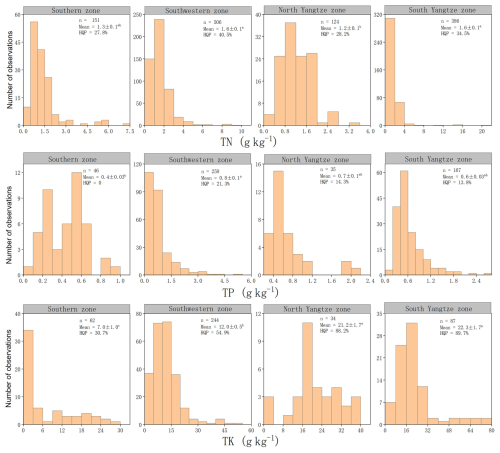
Figure 4Frequency distribution of soil TN, TP, and TK in tea plantations in each cultivation zone. n is the number of observations; HQP represents the percentage of high-quality tea plantations; letters on values indicate significant differences among cultivation zones at the 0.05 level.
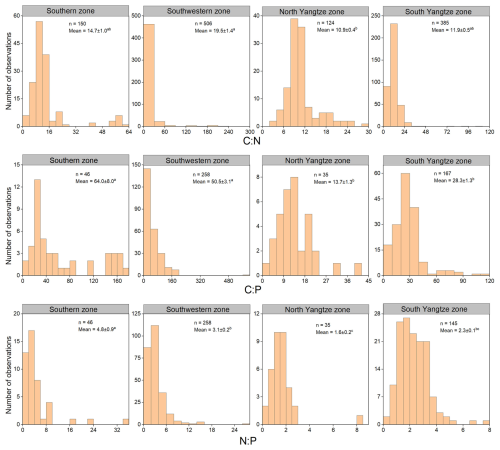
Figure 5Frequency distribution of the ratios of C:N, C:P, and N:P in tea plantations in each cultivation zone. n is the number of observations; letters on values indicate significant differences among cultivation zones at the 0.05 level.
3.2 Patterns of soil ecological stoichiometry and pH
Table 4 illustrates the correlations of pH, SOM, the concentrations, and stoichiometric ratios of soil nutrients against the geographic and climatic factors. The concentrations of soil nutrients, pH, and SOM, as well as the ratios of C:N and C:P, significantly decreased from west to east (P < 0.05), but the concentration of AP and the ratios of C:K, N:K, and P:K significantly increased from west to east (P < 0.05); the N:P ratio varied slightly along the longitude gradient (P > 0.05). Meanwhile, the concentrations of AN, AP, AK, TP, and TK and pH increased gradually with latitudes, while the concentration of SOM and the ratios of C:N, C:P, and N:P decreased with latitude (P < 0.05). However, ratios of C:K, N:K, and P:K varied slightly from south to north (P > 0.05). Correspondingly, concentrations of AN, AK, TN, and SOM, as well as pH and the ratios of C:P, N:P, C:K, and N:K, increased with elevation (P < 0.05), but the concentrations of AP and TK decreased with elevation (P < 0.05). Also, the TP concentration and the ratios of C:N and P:K varied slightly with the elevation (P > 0.05). Concentrations of AN, AK, and TK, as well as pH, significantly decreased (P < 0.05) with MAP and MAT. The change in MAP had an insignificant influence on the concentration of TP and all stoichiometric ratios of soil nutrients (P > 0.05). The concentration of AP and the ratios of C:K, N:K, and P:K were positively correlated with MAT (P < 0.05), but TP and the ratios of C:N, C:P, and N:P were slightly (P > 0.05) correlated with MAT.
Table 4Pearson correlations of geological and climatic factors and the age of tea plantations with soil pH and the concentrations and stoichiometric ratios of soil nutrients.
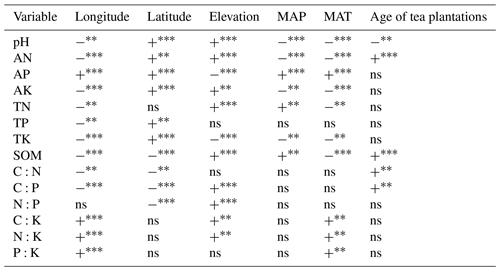
MAP is the mean annual precipitation. MAT is the mean annual temperature. −: negative correlation. +: positive correlation. * Correlation is significant at the 0.05 level. Correlation is significant at the 0.01 level. Correlation is significant at the 0.001 level. ns: correlation is not statistically significant.
Additionally, the status of soil nutrients and pH varied among soil classifications (Tables 5–6). Compared with other soil classifications, brown earth had significantly higher pH and higher concentrations of AP, AK, and TP (P < 0.05). The concentrations of AN and SOM as well as the ratios of C:P and N:P in Laterite soil were significantly higher than those in other soil classifications (P < 0.05). The TN concentration in yellow-brown earth and the C:N ratio in yellow earth were significantly higher than those in other soil classifications.
Table 5The variations of concentrations of soil nutrients among soil classifications.

Letters on values indicate significant differences among soil types at the 0.05 level. * Post hoc tests were not performed because one group had fewer than two cases.
3.3 Influences of management on ecological stoichiometry
Management practices significantly altered the status of soil nutrients and pH in tea plantations. Specifically, the age of tea plantations (or rotational cycle duration) positively affected the concentrations of AN and SOM, as well as the ratios of C:N and C:P, but negatively influenced soil pH (P < 0.05) (Table 4). Regarding the influence of fertilization strategies on the status of soil nutrients and pH in tea plantations (Tables 7–8), the concentrations of AN, AK, TN, TP and SOM, as well as pH and the N:P ratio, were relatively higher when applying organic fertilizer compared to other fertilization strategies. Using chemical or compound fertilizer alone was beneficial for improving the concentration of AP, but the combined application of chemical and compound fertilizer reduced soil pH. Besides, a combination of organic fertilizer with chemical and/or compound fertilizer also lowered soil pH and the concentrations of some nutrients.
Table 7The influence of fertilization strategies on the status of soil nutrients.
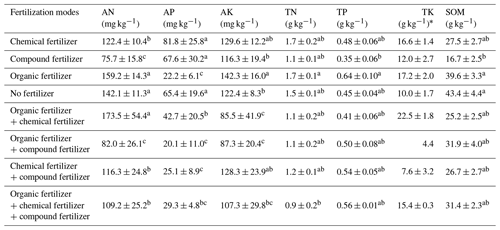
Letters on values indicate significant differences among fertilizer application modes at the 0.05 level. * Post hoc tests were not performed because one group had fewer than two cases.
3.4 Key drivers of the status of soil nutrients and pH
Among the influential factors including longitude, latitude, elevation, MAP, MAT, and the age of tea plantations, longitude exerted the strongest influence on the concentrations of AP and AK and the ratios of C:N and P:K, while elevation had the strongest effects on the concentrations of TN, TP, and SOM, as well as the ratios of C:P and C:K. The MAP and the age of tea plantations had the strongest influence on the N:K ratio and the concentration of AN, respectively (Table 9). The comparison between soil classification and fertilizer strategy showed that the fertilizer strategy had a stronger influence on soil pH; the concentrations of AN, AP, TN, and SOM; and the ratios of C:N, C:P, and N:P than soil classification, whereas soil classification had stronger influences on the concentration of TK and the ratios of C:K, N:K, and P:K (Table 10).
Table 9The standardized β coefficients of regression analyses.

MAP is mean annual precipitation, and MAT is mean annual temperature. Age is the age of tea plantation. * Correlation is significant at the 0.05 level. Correlation is significant at the 0.01 level. Correlation is significant at the 0.001 level. ns: correlation is not statistically significant.
Table 10The effect strengths (expressed as %SS, the percentage of sum of squares) of soil classifications and fertilizer strategies on soil nutrients and pH.

* correlation is significant at the 0.05 level. Correlation is significant at the 0.01 level. Correlation is significant at the 0.001 level. ns: correlation is not statistically significant.
4.1 Implications for soil ecological stoichiometry and pH
The results of this study indicated that Chinese tea plantations were experiencing soil nutrient deficiencies and imbalances, particularly in terms of TN, TP, and AK. The soil C:N ratio (16.5) in tea plantations was lower than the optimal C:N ratio (25) required for soil microbial decomposition of organic matter (Zhang et al., 2019). The soil C:P (41.9) and N:P (2.9) ratios in tea plantations were lower than those in global terrestrial ecosystems (110.9 and 7.9) (Xu et al., 2013). This could accelerate the decomposition of SOM and the mineralization and release of N and P (Wang et al., 2024). The ratios of C:K, N:K, and P:K in the present research were higher than those in previous studies (Wang et al., 2024), suggesting that tea plantations in China were restricted by K nutrients. The deficiency and imbalance of soil nutrients would restrict the growth of tea plants, increase the risk of disease infestation, and affect the activity of soil microorganisms (Amtmann et al., 2008), ultimately influencing the yield and quality of tea (Li, et al., 2017). It may also reduce the resilience of the tea plantation ecosystem to global climate change (Zheng et al., 2021). The possible reasons for soil nutrient deficiencies and imbalances may include biomass harvesting, mechanical disturbance of surface soil, and improper fertilization. Besides, high concentrations of available nutrients and extreme stoichiometric ratios of soil nutrients in certain parts of tea plantations suggest potential over-fertilization, which can lead to resource waste, environmental pollution, and downstream eutrophication. Strategies such as applying organic fertilizer and K fertilizer should be considered to improve the levels of TN, TP, and AK nutrient balance. Organic fertilizer can enhance the soil nutrient balance and reduce environmental pollution by releasing nutrients slowly (Shaji et al., 2021). However, most tea plantations had a high level of SOM, even higher than those (in the 0–20 cm soil layer) in China's terrestrial ecosystems (21.1 g kg−1), forests (24.7 g kg−1), and croplands (19.2 g kg−1) (Pan et al., 2021), but lower than that in global terrestrial ecosystems (98.6 g kg−1) (Xu et al., 2013). This indicates that soils in tea plantations can store a significant amount of organic carbon and act as a carbon pool.
Chinese tea plantations were also experiencing soil acidification. The average soil pH of tea plantations across China was 4.74, ranging from 2.97 to 8.38, which was slightly higher than the national average of 4.68, with a range of 3.96–5.48, as reported in Yan et al. (2020). This could be due to measures taken to address soil acidification, the encroachment of more tea plantations onto other land uses with higher base pH (Chen et al., 2018; Zhu et al., 2017), or the difference in soil parent materials and soil formation processes (Table 1). Soils developed from limestone and river alluvium, which are widely distributed in the north and south Yangtze zones, often exhibit high pH (> 7) (Geodata, 2024; Zhao et al., 2019), while stronger weathering and aluminous accumulation processes often lead to more acidic soils (Table 1). We also observed that a few tea plantations, mostly in the north Yangtze zone, had soil pH higher than 6.0. However, tea requires acidic soil for growth, and high soil pH can affect tea growth (Yan et al., 2018). To ensure tea productivity, the soil may need to be pretreated with special materials, such as aluminum sulfate (Fung et al., 2008), which could increase the investment in tea cultivation and potentially harm local ecosystems or increase the risk of environmental contamination, thus posing a burden on the sustainable development of the tea industry. Although the soil pH was still within the lower band of the optimal soil pH for tea growth, many tea plantations had a soil pH lower than 4.5, particularly in the southern and south Yangtze zones (Fig. 2). Furthermore, only 47.1 % of soil samples in the present study had a pH in the interval of 4.5–5.5, while 40.8 % and 10.1 % of the soil samples had pH levels lower than 4.5 and 4.0, respectively. Low pH increases the leaching loss of cationic nutrients such as K, Na, Ca, and Mg (Zhang et al., 2016) as well as inorganic carbon (Raza et al., 2021), thereby inhibiting tea growth, reducing yield and quality, and increasing greenhouse gas emissions (Fung et al., 2008); thus, low pH restricts the sustainable development of the tea industry in China and contributes to global climate change.
4.2 Factors influencing ecological stoichiometry
The status of soil nutrients and pH in China's tea plantations varied among cultivation zones (Figs. 2–6) and closely related to geographic and climatic factors (Table 4). At the national level, longitude, latitude, and elevation were the key factors affecting the status of soil nutrients and pH. This may be because geological positions influence the climate gradient and parent material, which in turn determine soil development (Tsozué et al., 2019) and eventually influence the status of soil nutrients and pH (Li et al., 2023). The significant correlations between the concentration of soil nutrients and MAP and MAT, as well as the significant variation in soil nutrient concentrations among soil classifications (Tables 5–6), also confirmed this.
Soil management strategies also influence the status of soil nutrients and pH. The age of tea plantations significantly influenced soil pH, the concentrations of AN and SOM, and the ratios of C:N and C:P. Tea is an aluminum (Al)-accumulating plant, and increased Al accumulation (Wang et al., 2010) over plantation years, associated with the application of N fertilizer, might be the main reason for the decrease in soil pH. The application of N fertilizer, mainly NH-N fertilizer, can accelerate soil acidification (Yan et al., 2018). Low pH restricts microbial activity and thus decreases SOC decomposition (Zheng et al., 2020), which consequently increases SOM (Fig. 7) and is thus beneficial for SOC sequestration. Fertilizer application was another factor strongly influencing the status of soil nutrients and pH. The comparison among fertilizer strategies indicated that the application of organic fertilizer was beneficial for improving the levels of soil nutrients and pH, especially for improvements in AK and TK (Tables 7–8). As Fig. 7 illustrates, soil AN and TN are positively correlated with SOM and TP but negatively correlated with TK. Therefore, the application of N fertilizer might be beneficial for SOC sequestration but could produce a negative effect on the nutrient balance between N and K.
Additionally, the effectiveness of influential factors varied. Among geological factors, elevation had a stronger influence on soil nutrients and pH, which could be due to its stronger control over local climate, thereby affecting the formation process and weathering of soil. Meanwhile, fertilizer strategies directly shaped the levels and balance of soil nutrients and pH at a relatively rapid pace and thus exerted a stronger influence on soil nutrients and pH than soil classification. However, it is worth noting that soil classification has a more significant influence on TK as K primarily comes from the soil itself, and the application of K fertilizer is not common in tea plantations.
4.3 Recommendations
Based on the results and discussions above, some recommendations were made for the improvement of the status of soil nutrients and pH in Chinese tea plantations. First, soil K concentrations were low in tea plantations; showed a decreasing trend from west to east and from north to south, similar to the findings of Geng et al. (2020); and were negatively affected by elevation. The application of K fertilizer is recommended for tea plantations, especially in southern regions and at high altitudes. Additionally, fertilization strategies should be based on local geological and climatic conditions, as they are influential factors for soil nutrients. Second, it is recommended to adjust fertilizer strategies, such as using less chemical fertilizer or replacing it with organic fertilizer, to tackle soil acidification, nutrient deficiencies, and imbalances. Third, as Table 4 illustrates, high temperatures harm the accumulation of soil nutrients and contribute to soil acidification. Cultivating shading trees in tea plantations, especially in the southern zone and at low elevations, is recommended to alleviate heat damage (Wu et al., 2015) and improve the activities, number, and richness of soil microorganisms (Wang et al., 2019), thereby benefiting soil nutrient balance and mitigating soil acidification. Fourth, the status of soil nutrients and pH should be assessed before converting other land uses to tea plantations to ensure the suitability of tea cultivation and proper soil management planning and to reduce the risk of environmental pollution. Finally, extending the cultivation duration of tea plantations is also recommended for SOC sequestration, as Wang et al. (2010) have indicated that the soil acidification rate decreases with tea cultivation time, and Wang et al. (2023) have indicated the great potential of SOC sequestration in tea plantations. This could contribute to achieving carbon neutrality in the tea industry and mitigating global warming.
4.4 Limitations, uncertainties, and future outlooks
It is difficult to accurately evaluate the status of soil nutrients and pH in tea plantations covering all soil types; tea plantation ages; geological, meteorological, and management varieties; and existing periods across the whole country due to the large and increasing tea cultivation area in China. In this study, only a few soil types and fertilizer strategies were compared because of data deficiency, and the study period spanned a decade. However, the amount and method of fertilizer application also influenced soil physicochemical and biological characteristics (Xie et al., 2019; Liu et al., 2025). Furthermore, more ecological management practices, such as intercropping, poultry raising, and application biochar or microbial fertilizers, have been introduced to tea plantation management (Duan et al., 2024; Liang et al., 2023). The comparison among a limited number of soil types and management strategies may restrict the application of the findings in this study. In this case, more efforts should be made to explore the effect of varied and combined management strategies on the soil physicochemical properties, either through experiments or meta-analysis, to support the sustainable development of the tea industry. Besides, the extended study period may exacerbate the unavoidable uncertainties arising from differences and variations in climate, soil texture, nutritional condition, and management practices among regions and provinces during this period, leading to uncertainties caused by legacy effects.
The data sources, methods of data collection, and uneven distribution of data for each soil nutrient and cultivation zone in this study will also introduce uncertainties. As stated in Sect. 2.2, soil data were collected from the published literature. Varied research methods among studies may lead to uncertainties. Moreover, the imprecise longitude and latitude of the study sites, extracted based on the name of the study area from Baidu Map, will cause uncertainty. In addition, MAT and MAP were adopted as climatic factors influencing soil nutrients and pH. However, the annual averages of MAT and MAP cannot reflect soil temperature and moisture or the distribution of temperature and precipitation throughout the year. The status of soil nutrients and pH may be influenced by the evenness of precipitation distribution, precipitation in growing seasons, or the occurrence of extreme climate events. Therefore, the influence of climate factors on soil nutrients and pH requires further investigation. As illustrated in Table 3 and Figs. 1–6, the numbers of observations for soil nutrients and cultivation zones were uneven, with more attention focused on available nutrients and pH and concentrating on the southwestern zone. Less attention has been paid to nutrient balance and other cultivation zones. This may affect the comprehensiveness of the assessment of the status of soil nutrients and acidification and the accuracy of comparisons among cultivation zones, thus requiring wider coverage of soil nutrients and cultivation areas in future research.
In addition to soil pH and nutrients of N, P, and K, many mineral elements are also important for the healthy growth of tea plants and thus the productivity and quality of tea (Han et al., 2011). Future research should pay more attention to other media and micronutrients in tea plantation soils. Moreover, a more accurate assessment of tea plantation soil nutrients should involve an in-depth investigation of the mechanisms and interactions between influential factors to guide the development of sustainable managerial strategies.
As suggested in Sect. 4.3 and the literature, organic management strategies, such as intercropping and applying organic fertilizer or biochar, are often recommended as effective ways to improve soil fertility, buffer soil acidification (Xie et al., 2021), and increase profits. However, organic management strategies are not always environmentally and economically sustainable. For example, Mohamad et al. (2014) have pointed out that applying manure in olive plantations results in higher costs and environmental impacts when assessed from a life cycle perspective, possibly due to higher energy or labor consumption required for transport and application (Rahmah et al., 2022). De Keyser et al. (2024) have also pointed out that mineral fertilizer plays an important role in the fertilizer mix. Therefore, the viability of soil management innovations should be comprehensively assessed from both environmental and economic aspects in a life cycle approach to evaluate whether the benefits of these practices outweigh the associated impacts and costs.
In this study, we assessed the status and spatial variations of soil nutrients and pH in Chinese tea plantations and analyzed the relationships between these soil characteristics and influential factors, including soil classification, management practices, and climatic and geographic factors using data collected from the literature. The results indicated that less than 45 % of the observed tea plantations could meet the standards for high-quality tea plantations, and more than 20 % of tea plantations were facing soil nutrient deficiencies, especially in TN, TP, and AK. A significant portion of tea plantations were also facing soil acidification. The status of soil nutrients and pH varied among cultivation zones due to the influence of geographic and climatic factors. Additionally, management practices, including the age of tea plantations and fertilization strategies, had significant influences on the status of soil nutrients and pH. Based on the results, recommendations such as applying K fertilizer in southern and high-altitude tea plantations, adjusting fertilization strategies, extending the cultivation duration of tea plantations, and planting shading trees were proposed to mitigate soil acidification and to improve the concentrations and balance of soil nutrients and SOC sequestration ability in Chinese tea plantations. Furthermore, more efforts should be made to cover a broader range of soil nutrients and cultivation areas in the assessment and to explore the mechanisms and interactions between influential factors.
The data generated in this study are available from the first or corresponding author upon reasonable request.
The supplement related to this article is available online at: https://doi.org/10.5194/soil-11-175-2025-supplement.
Conceptualization, funding acquisition, data collection, analyses, writing and revision: DW. Conceptualization, writing and revision, funding acquisition: WY. Writing and revision, funding acquisition: BL. Writing and revision: FL, JH, ZW, RC, and YZ.
The contact author has declared that none of the authors has any competing interests.
Publisher’s note: Copernicus Publications remains neutral with regard to jurisdictional claims made in the text, published maps, institutional affiliations, or any other geographical representation in this paper. While Copernicus Publications makes every effort to include appropriate place names, the final responsibility lies with the authors.
We thank Bing Sheng Wu for the help with data collection.
This research has been supported by the National Natural Science Foundation of China (grant nos. U22A20450 and 32101386), the Natural Science Foundation of Zhejiang Province (grant no. LQ22C030004), and the Science and Technology Plan Project of Taizhou (grant nos. 21nya08 and 23sfb08).
This paper was edited by Maria Jesus Gutierrez Gines and reviewed by two anonymous referees.
Amtmann, A., Troufflard, S., and Armengaud, P.: The effect of potassium nutrition on pest and disease resistance in plants, Physiol. Plantarum, 133, 682–691, https://doi.org/10.1111/j.1399-3054.2008.01075.x, 2008.
Baker, G. H., Carter, P. J., Curry, J. P., Cultreri, O., and Beck, A.: Clay content of soil and its influence on the abundance of Aporrectodea trapezoides Duges (Lumbricidae), Appl. Soil Ecol., 9, 333–337, https://doi.org/10.1016/S0929-1393(98)00085-7, 1998.
CAEY (Council of Agriculture Executive Yuan): Agricultural Statistics, https://agrstat.coa.gov.tw/, last access: 13 December 2023.
Chen, C., Xiao, W., and Chen, H. Y. H.: Mapping global soil acidification under N deposition, Glob. Change Biol., 29, 4652–4661, https://doi.org/10.1111/gcb.16813, 2023.
Chen, Y., Wang, F., Wu, Z., Zhang, W., You, Z., and Qiu, C.: Effect of converting forestland to tea plantation on physiochemical properties of soil, Acta Tea Sinica, 59, 205–210, 2018.
Chen, Y., Li, Y., Duan, Y., Wang, L., Wang, X., Yao, C., Chen, Y., Cao, W., and Niu, Y.: Patterns and driving factors of soil ecological stoichiometry in typical ecologically fragile areas of China, Catena, 219, 106628, https://doi.org/10.1016/j.catena.2022.106628, 2022.
De Keyser, E., Rowe, T., Giacomella, L., Jasiński, D., Mathijs, E., and Vranken, L.: Combining life-cycle assessment and linear programming to optimize social fertilizer costs, J. Environ. Manage., 369, 122225, https://doi.org/10.1016/j.jenvman.2024.122225, 2024.
Di, S., Zong, M., Li, S., Li, H., Duan, C., Peng, C., Zhao, Y., Bai, J., Lin, C., Feng, Y., Huang, W., and Wang, D.: The effects of the soil environment on soil organic carbon in tea plantations in Xishuangbanna, southwestern China, Agr. Ecosyst. Environ., 297, 106951, https://doi.org/10.1016/j.agee.2020.106951, 2020.
Duan, Y., Wang, G., Liang, L., Wang, M., Jiang, J., Ma, Y., Zhu, X., Wu, J., and Fang, W.: Intercropping fruit trees in tea plantation improves soil properties and the formation of tea quality components, Plant Physiol. Bioch., 210, 108574, https://doi.org/10.1016/j.plaphy.2024.108574, 2024.
Fan, L. and Han, W.: Soil respiration after forest conversion to tea gardens: A chronosequence study, Catena, 190, 104532, https://doi.org/10.1016/j.catena.2020.104532, 2020.
Fang, X., Xue, Z., Li, B., and An, S.: Soil organic carbon distribution in relation to land use and its storage in a small watershed of the Loess Plateau, China, Catena, 88, 6–13, https://doi.org/10.1016/j.catena.2011.07.012, 2012.
FAO (Food and Agriculture Organization of the United Nations): International tea market: market situation, prospects and emerging issues, https://www.fao.org/3/cc0238en/cc0238en.pdf (last access: 16 May 2024), 2024.
FAO (Food and Agriculture Organization of the United Nations) and CAAS (Chinese Academy of Agricultureal Sciences): Carbon neutral tea production in China – Three pilot case studies, http://www.fao.org/3/cb4580en/cb4580en.pdf (last access: 16 May 2023), 2021.
Fung, K. F., Carr, H. P., Zhang, J., and Wong, M. H.: Growth and nutrient uptake of tea under different aluminium concentrations, J. Sci. Food Agr., 88, 1582–1591, https://doi.org/10.1002/jsfa.3254, 2008.
Ge, N., Wei, X., Wang, X., Liu, X., Shao, M., Jia, X., Li, X., and Zhang, Q.: Soil texture determines the distribution of aggregate-associated carbon, nitrogen and phosphorous under two contrasting land use types in the Loess Plateau, Catena, 172, 148–157, https://doi.org/10.1016/j.catena.2018.08.021, 2019.
Geng, Z., Jia, H., Zhang, J., and Dai, W.: Soil Science, 2nd edn., Science Publishing & Media Ltd, Beijing, China, ISBN: 9787030662705, 2020.
Geodata (Geographic Data Sharing Infrastructure): Pedogenic parent material map of China, College of Urban and Environmental Science, Peking University, https://geodata.pku.edu.cn/index.php?c=content&a=show&id=1401, last access: 20 October 2024.
Han, W. X., Fang, J. Y., Reich, P. B., Ian Woodward, F., and Wang, Z.: Biogeography and variability of eleven mineral elements in plant leaves across gradients of climate, soil and plant functional type in China, Ecol. Lett., 14, 788–796, https://doi.org/10.1111/j.1461-0248.2011.01641.x, 2011.
Hua, D. and Li, J.: Evaluation of soil nutrients in tea region of Shangnan County, Modern Agricultural Science and Technology 20, 184–185, 194, 2018.
Jin, X., Cai, J., Yang, S., Li, S., Shao, X., Fu, C., Li, C., Deng, Y., Huang, J., Ruan, Y., and Li, C.: Partial substitution of chemical fertilizer with organic fertilizer and slow-release fertilizer benefits soil microbial diversity and pineapple fruit yield in the tropics, Appl. Soil Ecol., 189, 104974, https://doi.org/10.1016/j.apsoil.2023.104974, 2023.
Li, S., Wu, X., Xue, H., Gu, B., Cheng, H., Zeng, J., Peng, C., Ge., Y., and Chang, J.: Quantifying carbon storage for tea plantations in China, Agr. Ecosyst. Environ., 141, 390–398, https://doi.org/10.1016/j.agee.2011.04.003, 2011.
Li, X., Xiao, G., Guo, Z., and Wang, J.: Spatial distribution characteristics of farmland soil organic carbon and its effect on salinization in the eastern foot of Helan Mountain, Journal of Agro-Environment Science, 42, 612–623, https://doi.org/10.11654/jaes.2022-0520, 2023.
Liang, Y., Cao, R., Wang, Z., Li, X., Wang, H., Feng, Z., Dong, H., An, W., Wu, Q., and Yang, W.: Response of soil microbial quotient to typhoon disturbance in difference management modes of tea plantations, Acta Ecologica Sinica, 43, 7216–7225, https://doi.org/10.20103/j.stxb.202209182671, 2023.
Liu, B., Zhang, Y., Yi, X., Zheng, H., Ni, K., Ma, Q., Cai, Y., Ma, L., Shi, Y., Yang, X., and Ruan, J.: Partially replacing chemical fertilizer with manure improves soil quality and ecosystem multifunctionality in a tea plantation, Agr. Ecosyst. Environ., 378, 109284, https://doi.org/10.1016/j.agee.2024.109284, 2025.
Malik, A. A., Puissant, J., Buckeridge, K. M., Goodall, T., Jehmlich, N., Chowdhury, S., Gweon, H. S., Peyton,J. M., Mason, K. E., van Agtmaal, M., Blaud, A., Clark, I. M., Whitaker, J., Pywell, R. F., Ostle, N., Gleixner, G., and Griffiths, R. I.: Land use driven change in soil pH affects microbial carbon cycling processes, Nat. Commun., 9, 3591, https://doi.org/10.1038/s41467-018-05980-1, 2018.
Mohamad, R. S., Verrastro, V., Cardone, G., Bteich, M. R., Favia, M., Moretti, M., and Roma, R.: Optimization of organic and conventional olive agricultural practices from a life cycle assessment and life cycle costing perspectives, J. Clean. Prod., 70, 78–89, https://doi.org/10.1016/j.jclepro.2014.02.033, 2014.
NBS (National Bureau of Statistics): National Data, https://data.stats.gov.cn/easyquery.htm?cn=C01, last access: 5 April 2024.
Neina, D.: The role of soil pH in plant nutrition and soil remediation, Applied and Environmental Soil Science, 2019, 5794869, https://doi.org/10.1155/2019/5794869, 2019.
Pan, Y., Fang, F., and Tang, H.: Patterns and internal stability of carbon, nitrogen, and phosphorus in soils and soil microbial biomass in terrestrial ecosystems in China: A data synthesis, Forests, 12, 1544, https://doi.org/10.3390/f12111544, 2021.
Quan, Y., Li, J., Zhang, H., Fan, Y., and Jing, B.: Effects of reduction of chemical fertilizer and organic manure supplement on soil nutrients in Xinyang tea gargen and the quality of spring tea, Henan Science, 38, 1781–1785, 2020.
Rahmah, D. M., Putra, A. S., Ishizaki, R., Noguchi, R., and Ahamed, T.: A life cycle assessment of organic and chemical fertilizers for coffee production to evaluate sustainability toward the energy-environment-economic nexus in Indonesia, Sustainability, 14, 3912, https://doi.org/10.3390/su14073912, 2022.
Raza, S., Zamanian, K., Ullah, S., Kuzyakov, Y., Virto, I., and Zhou, J.: Inorganic carbon losses by soil acidification jeopardize global efforts on carbon sequestration and climate change mitigation, J. Clean. Prod., 315, 128036, https://doi.org/10.1016/j.jclepro.2021.128036, 2021.
Rodríguez Martín, J. A., Álvaro-Fuentes, J., Gonzalo, J., Gil, C., Ramos-Miras, J. J., Grau Corbí, J. M., and Boluda, R.: Assessment of the soil organic carbon stock in Spain, Geoderma, 264, 117–125, https://doi.org/10.1016/j.geoderma.2015.10.010, 2016.
Ronnenberg, K. and Wesche, K.: Effects of fertilization and irrigation on productivity, plant nutrient contents and soil nutrients in southern Mongolia, Plant Soil, 340, 239–251, https://doi.org/10.1007/s11104-010-0409-z, 2011.
Shaji, H., Chandran, V., and Mathew, L.: Chapter 13 - Organic fertilizers as a route to controlled release of nutrients, in: Controlled release fertilizers for sustainable agriculture, edited by: Lewu, F. B., Volova, T., Thomas, S., and Rakhimol, K. R., Academic Press, 231–245, https://doi.org/10.1016/B978-0-12-819555-0.00013-3, 2021.
Shao, W., Wang, Q., Guan, Q., Luo, H., Ma, Y., and Zhang, J.: Distribution of soil available nutrients and their response to environmental factors based on path analysis model in arid and semi-arid area of northwest China, Sci. Total Environ., 827, 154254, https://doi.org/10.1016/j.scitotenv.2022.154254, 2022.
Shi, R. Y., Liu, Z. D., Li, Y., Jiang, T., Xu, M., Li, J. Y., and Xu, R. K.: Mechanisms for increasing soil resistance to acidification by long-term manure application, Soil Till. Res., 185, 77–84, https://doi.org/10.1016/j.still.2018.09.004, 2019.
Shi, S., Peng, C., Wang, M., Zhu, Q., Yang, G., Yang, Y., Xi, T., and Zhang, T.: A global meta-analysis of changes in soil carbon, nitrogen, phosphorus and sulfur, and stoichiometric shifts after forestation, Plant Soil, 407, 323–340, https://doi.org/10.1007/s11104-016-2889-y, 2016.
Su, L., Du, H., Zeng, F., Peng, W., Rizwan, M., Núñez-Delgado, A., Zhou, Y., Song, T., and Wang, H.: Soil and fine roots ecological stoichiometry in different vegetation restoration stages in a karst area, southwest China, J. Environ. Manage., 252, 109694, https://doi.org/10.1016/j.jenvman.2019.109694, 2019.
Tsozué, D., Nghonda, J. P., Tematio, P., and Basga, S. D.: Changes in soil properties and soil organic carbon stocks along an elevation gradient at Mount Bambouto, Central Africa, Catena, 175, 251–262., https://doi.org/10.1016/j.catena.2018.12.028, 2019.
Vitousek, P. M., Naylor, R., Crews, T., David, M. B., Drinkwater, L. E., Holland, E., Johnes, O., Katzenberger, J., Martinelli, L. A., Matson, P. A., Nziguheba, G., Ojima, D., Palm, C. A., Robertson, G. P., Sanchez, P. A., Townsend, A. R., and Zhang, F. S.: Nutrient imbalances in agricultural development, Science, 324, 1519–1520, https://doi.org/10.1126/science.1170261, 2009.
Wang, D., Wu, B. S., Li, F., Li, X., Wang, Z., Hou, J., Cao, R., and Yang, W.: Soil organic carbon stock in China's tea plantations and their great potential of carbon sequestration, J. Clean. Prod., 421, 138485, https://doi.org/10.1016/j.jclepro.2023.138485, 2023.
Wang, H., Xu, R. K., Wang, N., and Li, X. H.: Soil acidification of alfisols as influenced by tea cultivation in eastern China, Pedosphere, 20, 799–806, https://doi.org/10.1016/S1002-0160(10)60070-7, 2010.
Wang, L., Liao, Y., Li, X., Wu, C., Wang, J., Hou, L., Wu, Q., Zhang, Y., Shen, C., and Wang, W.: Ecological stoichiometric ratios of soil carbon, nitrogen, phosphorus and potassium and their effects on fungal diversities in different rock tea producing areas, Soil, 56, 1007–1017, https://doi.org/10.13758/j.cnki.tr.2024.05.011, 2024.
Wang, M., Chen, H., Zhang, W., and Wang, K.: Soil nutrients and stoichiometric ratios as affected by land use and lithology at county scale in a karst area, southwest China, Sci. Total Environ., 619, 1299–1307, https://doi.org/10.1016/j.scitotenv.2017.11.175, 2018.
Wang, S., Li, T., Zheng, Z., Zhang, X., and Chen, H. Y.: Soil organic carbon and nutrients associated with aggregate fractions in a chronosequence of tea plantations, Ecol. Indic., 101, 444–452, https://doi.org/10.1016/j.ecolind.2019.01.043, 2019.
Wu, S., Lv, L., Jin, K., Zhao, F., Zheng, J., Dang, Y., and Jiang, S.: Effects of different shading degrees on eco-environment of tea plantations during hot dry season, Tianjin Agricultural Sciences, 21, 115–118, https://doi.org/10.3969/j.issn.1006-6500.2015.11.027, 2015.
Wu, T., Liu, W., Wang, D., Zou, Y., Lin, R., Yang, Q., Gbokie Jr., T., Bughio, M. A., Li, Q., and Wang, J.: Organic management improves soil phosphorus availability and microbial properties in a tea plantation after land conversion from longan (Dimocarpus longan), Appl. Soil Ecol., 154, 103642, https://doi.org/10.1016/j.apsoil.2020.103642, 2020.
Xie, S., Feng, H., Yang, F., Zhao, Z., Hu, X., Wei, C., Liang, T., Li, H., and Geng, Y.: Does dual reduction in chemical fertilizer and pesticides improve nutrient loss and tea yield and quality? A pilot study in a green tea garden in Shaoxing, Zhejiang Province, China, Environ. Sci. Pollut. R. 26, 2464–2476, https://doi.org/10.1007/s11356-018-3732-1, 2019.
Xie, S., Yang, F., Feng, H., Yu, Z., Liu, C., Wei, C., and Liang, T.: Organic fertilizer reduced carbon and nitrogen in runoff and buffered soil acidification in tea plantations: Evidence in nutrient contents and isotope fractionations, Sci. Total Environ., 762, 143059, https://doi.org/10.1016/j.scitotenv.2020.143059, 2021.
Xin, Z., Qin, Y., and Yu, X.: Spatial variability in soil organic carbon and its influencing factors in a hilly watershed of the Loess Plateau, China, Catena, 137, 660–669, https://doi.org/10.1016/j.catena.2015.01.028, 2016.
Xu, X., Thornton, P. E., and Post, W. M.: A global analysis of soil microbial biomass carbon, nitrogen and phosphorus in terrestrial ecosystems, Global Ecol. Biogeogr., 22, 737–749, https://doi.org/10.1111/geb.12029, 2013.
Yan, B., Zhang, Y., Wang, Y., Rong, X., Peng, J., Fei, J., and Luo, G.: Biochar amendments combined with organic fertilizer improve maize productivity and mitigate nutrient loss by regulating the C–N–P stoichiometry of soil, microbiome, and enzymes, Chemosphere, 324, 138293, https://doi.org/10.1016/j.chemosphere.2023.138293, 2023.
Yan, P., Shen, C., Fan, L., Li, X., Zhang, L., Zhang, L., and Han, W.: Tea planting affects soil acidification and nitrogen and phosphorus distribution in soil, Agr. Ecosyst. Environ., 254, 20–25, https://doi.org/10.1016/j.agee.2017.11.015, 2018.
Yan, P., Wu, L., Wang, D., Fu, J., Shen, C., Li, X., Zhang, L., Zhang, L., Fan, L., and Wenyan, H.: Soil acidification in Chinese tea plantations, Sci. Total Environ., 715, 136963, https://doi.org/10.1016/j.scitotenv.2020.136963, 2020.
Yang, X., Ni, K., Shi, Y., Yi, X., Ji, L., Wei, S., Jiang, Y., Zhang, Y., Cai, Y., Ma, Q., Tang, S., Ma, L., and Ruan, J.: Metagenomics reveals N-induced changes in carbon-degrading genes and microbial communities of tea (Camellia sinensis L.) plantation soil under long-term fertilization, Sci. Total Environ., 856, 159231, https://doi.org/10.1016/j.scitotenv.2022.159231, 2023.
Zhang, J., Su, L., Wang, L. P., Bao, Y. L., Lu, J. W., Gao, X. L., Chen, T., and Cao, J. J.: The effect of vegetation cover on ecological stoichiometric ratios of soil carbon, nitrogen and phosphorus: A case study of the Dunhuang Yangguan wetland, Acta Ecologica Sinica, 39, 580–589, https://doi.org/10.5846/stxb201712132239, 2019.
Zhang, M., Chen, Y., Fan, D., Zhu, Q., Pan, Z., Fan, K., and Wang, X.: Temporal evolution of carbon storage in Chinese tea plantations from 1950 to 2010, Pedosphere, 27, 121–128, https://doi.org/10.1016/S1002-0160(15)60098-4, 2017.
Zhang, X. Y., Yin, T. Y., Zhou, S. Q., and Hu, J.: Current status of soil acidification in tea plantations in China's tea-planting provinces, Guizhou Science, 40, 81–85, 2022.
Zhang, Y., He, X., Liang, H., Zhao, J., Zhang, Y., and Xu, C.: Long-term tobacco plantation induces soil acidification and soil base cation loss, Environ. Sci. Pollut. R., 23, 5442–5450, https://doi.org/10.1007/s11356-015-5673-2, 2016.
Zhang, Z. and Shu, Y.: Analysis of soil nutrient characteristics of tea gardens in southwest China based on bibliometrics, Soil and Fertilizer Sciences in China, 5, 42–52, https://doi.org/10.11838/sfsc.1673-6257.20359, 2021.
Zhao, K., Wang, B., Xu, M., Cai, Z., Shi, W., and Ma, H.: Changes in pH with depths of soils derived from different parent materials and analysis of acidification in Southern China, Journal of Plant Nutrition and Fertilizers, 25, 1308–1315, 2019.
Zheng, N., Yu, Y., Wang, J., Chapman, S. J., Yao, H., and Zhang, Y.: The conversion of subtropical forest to tea plantation changes the fungal community and the contribution of fungi to N2O production, Environ. Pollut., 265, 115106, https://doi.org/10.1016/j.envpol.2020.115106, 2020.
Zheng, S., Xia, Y., Hu, Y., Chen, X., Rui, Y., Gunina, A., He, X., Ge, T., Wu, J., Su, Y., and Kuzyakov, Y.: Stoichiometry of carbon, nitrogen, and phosphorus in soil: Effects of agricultural land use and climate at a continental scale, Soil Till. Res., 209, 104903, https://doi.org/10.1016/j.still.2020.104903, 2021.
Zheng, Z., He, X., and Li, T.: Status and evaluation of the soil nutrients in tea plantation, Procedia Environ. Sci., 12, 45–51, https://doi.org/10.1016/j.proenv.2012.01.245, 2012.
Zhu, H., Chen, J., and Chen, S.: Soil Geography, 3rd edn., Higher Education Press, Beijing, China, ISBN: 9787040512335, 2019.
Zhu, Q., Liao, K., Lai, X., and Lv, L.: Scale-dependent effects of environmental factors on soil organic carbon, soil nutrients and stoichiometry under two contrasting land-use types, Soil Use Manage., 37, 243–256, https://doi.org/10.1111/sum.12695, 2021.
Zhu, Q. C., Liu, X. J., Hao, T. X., Zeng, M. F., Shen, J. B., and Zhang, F. S.: Modeling soil acidification in typical Chinese cropping systems. Sci. Total Environ., 613–614, 1339–1348, https://doi.org/10.1016/j.scitotenv.2017.06.257, 2018.
Zhu, R., Zheng, Z., Li, T., Zhang, X., He, S., Wang, Y., Liu, T., and Li, W.: Dynamics of soil organic carbon mineralization in tea plantations converted from farmland at Western Sichuan, China, PloS ONE, 12, e0185271, https://doi.org/10.1371/journal.pone.0185271, 2017.





